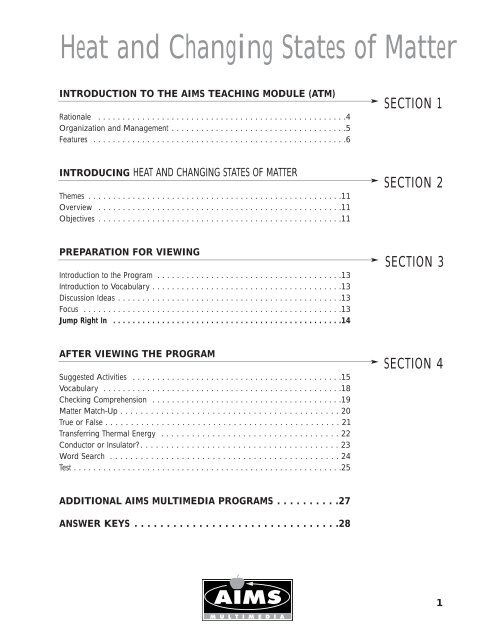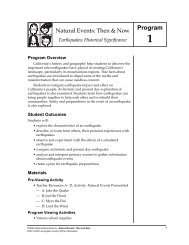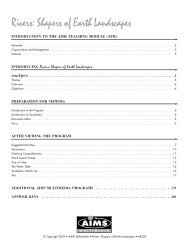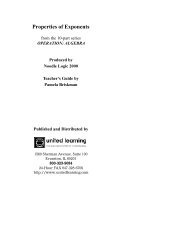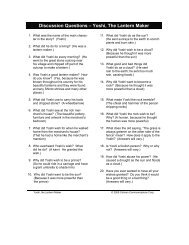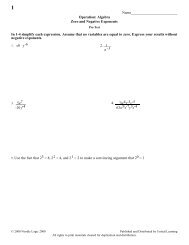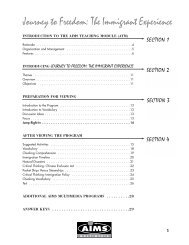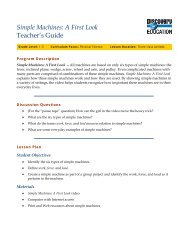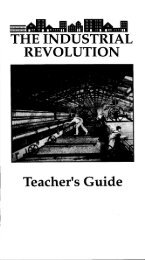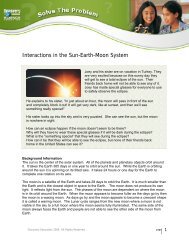Heat and Changing States of Matter - Discovery Education
Heat and Changing States of Matter - Discovery Education
Heat and Changing States of Matter - Discovery Education
You also want an ePaper? Increase the reach of your titles
YUMPU automatically turns print PDFs into web optimized ePapers that Google loves.
<strong>Heat</strong> <strong>and</strong> <strong>Changing</strong> <strong>States</strong> <strong>of</strong> <strong>Matter</strong>INTRODUCTION TO THE AIMS TEACHING MODULE (ATM)Rationale . . . . . . . . . . . . . . . . . . . . . . . . . . . . . . . . . . . . . . . . . . . . . . . . . . .4Organization <strong>and</strong> Management . . . . . . . . . . . . . . . . . . . . . . . . . . . . . . . . . . . .5Features . . . . . . . . . . . . . . . . . . . . . . . . . . . . . . . . . . . . . . . . . . . . . . . . . . . .6SECTION 1INTRODUCING HEAT AND CHANGING STATES OF MATTERThemes . . . . . . . . . . . . . . . . . . . . . . . . . . . . . . . . . . . . . . . . . . . . . . . . . . . .11Overview . . . . . . . . . . . . . . . . . . . . . . . . . . . . . . . . . . . . . . . . . . . . . . . . . .11Objectives . . . . . . . . . . . . . . . . . . . . . . . . . . . . . . . . . . . . . . . . . . . . . . . . . .11SECTION 2PREPARATION FOR VIEWINGIntroduction to the Program . . . . . . . . . . . . . . . . . . . . . . . . . . . . . . . . . . . . . .13Introduction to Vocabulary . . . . . . . . . . . . . . . . . . . . . . . . . . . . . . . . . . . . . . .13Discussion Ideas . . . . . . . . . . . . . . . . . . . . . . . . . . . . . . . . . . . . . . . . . . . . . .13Focus . . . . . . . . . . . . . . . . . . . . . . . . . . . . . . . . . . . . . . . . . . . . . . . . . . . . .13Jump Right In . . . . . . . . . . . . . . . . . . . . . . . . . . . . . . . . . . . . . . . . . . . . . . .14SECTION 3AFTER VIEWING THE PROGRAMSuggested Activities . . . . . . . . . . . . . . . . . . . . . . . . . . . . . . . . . . . . . . . . . . .15Vocabulary . . . . . . . . . . . . . . . . . . . . . . . . . . . . . . . . . . . . . . . . . . . . . . . . .18Checking Comprehension . . . . . . . . . . . . . . . . . . . . . . . . . . . . . . . . . . . . . . .19<strong>Matter</strong> Match-Up . ..........................................20True or False . .............................................21Transferring Thermal Energy ...................................22Conductor or Insulator? .......................................23Word Search .............................................24Test . . . . . . . . . . . . . . . . . . . . . . . . . . . . . . . . . . . . . . . . . . . . . . . . . . . . . . .25SECTION 4ADDITIONAL AIMS MULTIMEDIA PROGRAMS . . . . . . . . . .27ANSWER KEYS . . . . . . . . . . . . . . . . . . . . . . . . . . . . . . . .281
© Copyright 1999 AIMS MultimediaAll Rights Reserved. No part <strong>of</strong> this work may be reproduced or transmitted without written permission <strong>of</strong> AIMSMultimedia with these exceptions: Persons or schools purchasing this AIMS Teaching Module may reproduceconsumable ATM pages, identified in Section 4, for student or classroom use.AIMS Multimedia is a leading producer <strong>and</strong> distributor <strong>of</strong> educational programs serving schools <strong>and</strong> libraries fornearly 40 years. AIMS draws upon the most up-to-date knowledge, existing <strong>and</strong> emerging technologies, <strong>and</strong> all <strong>of</strong>the instructional <strong>and</strong> pedagogical resources available to develop <strong>and</strong> distribute educational programsin film, videocassette, laserdisc, CD-ROM <strong>and</strong> CD-i formats.Persons or schools interested in obtaining additional copies <strong>of</strong> this AIMS Teaching Module, please contact:AIMS Multimedia1-800-FOR-AIMS1-800-367-24672© Copyright 1999 AIMS Multimedia
Congratulations!You have chosen a learning programthat will actively motivate your studentsAND provide you with easily accessible<strong>and</strong> easily manageable instructionalguidelines designed to make yourteaching role efficient <strong>and</strong> rewarding.The AIMS Teaching Module providesyou with a video program keyed to yourclassroom curriculum, instructions <strong>and</strong>guidelines for use, plus a comprehensiveteaching program containing awide range <strong>of</strong> activities <strong>and</strong> ideas forinteraction between all content areas.Our authors, educators, <strong>and</strong> consultantshave written <strong>and</strong> reviewed the AIMSTeaching Modules to align with theEducate America Act: Goals 2000.This ATM, with its clear definition <strong>of</strong>manageability, both in the classroom<strong>and</strong> beyond, allows you to tailor specificactivities to meet all <strong>of</strong> your classroomneeds.© Copyright 1999 AIMS Multimedia3
RATIONALEIn today’s classrooms, educational pedagogyis <strong>of</strong>ten founded on Benjamin S.Bloom’s “Six Levels <strong>of</strong> CognitiveComplexity.” The practical application<strong>of</strong> Bloom’s Taxonomy is to evaluate students’thinking skills on these levels,from the simple to the complex:Knowledge (rote memory skills),Comprehension (the ability to relate orretell), Application (the ability to applyknowledge outside its origin), Analysis(relating <strong>and</strong> differentiating parts <strong>of</strong> awhole), Synthesis (relating parts to awhole), <strong>and</strong> Evaluation (making a judgmentor formulating an opinion).The AIMS Teaching Module is designedto facilitate these intellectual capabilities,AND to integrate classroom experiences<strong>and</strong> assimilation <strong>of</strong> learningwith the students’ life experiences, realities,<strong>and</strong> expectations. AIMS’ learnerverification studies prove that our AIMSTeaching Modules help students toabsorb, retain, <strong>and</strong> to demonstrate abilityto use new knowledge in their world.Our educational materials are written<strong>and</strong> designed for today’s classroom,which incorporates a wide range <strong>of</strong>intellectual, cultural, physical, <strong>and</strong> emotionaldiversities.4© Copyright 1999 AIMS Multimedia
ORGANIZATION ANDMANAGEMENTTo facilitate ease in classroom manageability,the AIMS Teaching Module isorganized in four sections. You arereading Section 1, Introduction to theAims Teaching Module (ATM).SECTION 2,INTRODUCING THIS ATMwill give you the specific informationyou need to integrate the program intoyour classroom curriculum.SECTION 3,PREPARATION FOR VIEWINGprovides suggestions <strong>and</strong> strategies formotivation, language preparedness,readiness, <strong>and</strong> focus prior to viewingthe program with your students.SECTION 4,AFTER VIEWING THE PROGRAMprovides suggestions for additionalactivities plus an assortment <strong>of</strong> consumableassessment <strong>and</strong> extended activities,designed to broaden comprehension <strong>of</strong>the topic <strong>and</strong> to make connections toother curriculum content areas.© Copyright 1999 AIMS Multimedia5
FEATURESINTRODUCING EACH ATMSECTION 2Your AIMS Teaching Module isdesigned to accompany a video programwritten <strong>and</strong> produced by some <strong>of</strong>the world’s most credible <strong>and</strong> creativewriters <strong>and</strong> producers <strong>of</strong> educationalprogramming. To facilitate diversity <strong>and</strong>flexibility in your classroom, your AIMSTeaching Module features these components:ThemesThe Major Theme tells how this AIMSTeaching Module is keyed into the curriculum.Related Themes <strong>of</strong>fer suggestionsfor interaction with othercurriculum content areas, enablingteachers to use the teaching module toincorporate the topic into a variety <strong>of</strong>learning areas.OverviewThe Overview provides a synopsis <strong>of</strong>content covered in the video program.Its purpose is to give you a summary <strong>of</strong>the subject matter <strong>and</strong> to enhance yourintroductory preparation.ObjectivesThe ATM learning objectives provideguidelines for teachers to assess whatlearners can be expected to gain fromeach program. After completion <strong>of</strong> theAIMS Teaching Module, your studentswill be able to demonstrate dynamic<strong>and</strong> applied comprehension <strong>of</strong> thetopic.6© Copyright 1999 AIMS Multimedia
PREPARATION FOR VIEWINGSECTION 3In preparation for viewing the videoprogram, the AIMS Teaching Module<strong>of</strong>fers activity <strong>and</strong>/or discussionideas that you may use in any orderor combination.Introduction To The ProgramIntroduction to the Program isdesigned to enable students to recallor relate prior knowledge about thetopic <strong>and</strong> to prepare them for whatthey are about to learn.Introduction To VocabularyIntroduction to Vocabulary is areview <strong>of</strong> language used in the program:words, phrases, usage. Thisvocabulary introduction is designed toensure that all learners, including limitedEnglish pr<strong>of</strong>iciency learners, willhave full underst<strong>and</strong>ing <strong>of</strong> the languageusage in the content <strong>of</strong> the program.Discussion IdeasDiscussion Ideas are designed to helpyou assess students’ prior knowledgeabout the topic <strong>and</strong> to give students apreview <strong>of</strong> what they will learn.Active discussion stimulates interest ina subject <strong>and</strong> can motivate even themost reluctant learner. Listening, aswell as speaking, is active participation.Encourage your students to participateat the rate they feelcomfortable. Model sharing personalexperiences when applicable, <strong>and</strong>model listening to students’ ideas <strong>and</strong>opinions.FocusHelp learners set a purpose forwatching the program with Focus,designed to give students a focalpoint for comprehension continuity.Jump Right InJump Right In provides abbreviatedinstructions for quick management <strong>of</strong>the program.AFTER VIEWING THE PROGRAMSECTION 4After your students have viewed theprogram, you may introduce any orall <strong>of</strong> these activities to interact withother curriculum content areas, providereinforcement, assess comprehensionskills, or provide h<strong>and</strong>s-on<strong>and</strong> in-depth extended study <strong>of</strong> thetopic.© Copyright 1999 AIMS Multimedia7
SUGGESTEDACTIVITIESThe Suggested Activities <strong>of</strong>fer ideasfor activities you can direct in theclassroom or have your students completeindependently, in pairs, or insmall work groups after they haveviewed the program. To accommodateyour range <strong>of</strong> classroom needs,the activities are organized into skillscategories. Their labels will tell youhow to identify each activity <strong>and</strong> helpyou correlate it into your classroomcurriculum. To help you schedule yourclassroom lesson time, the AIMShourglass gives you an estimate <strong>of</strong> thetime each activity should require.Some <strong>of</strong> the activities fall into thesecategories:Meeting IndividualNeedsThese activities are designed to aid inclassroom continuity. Reluctant learners<strong>and</strong> learners acquiring Englishwill benefit from these activitiesgeared to enhance comprehension <strong>of</strong>language in order to fully grasp contentmeaning.MATHCurriculumConnectionsMany <strong>of</strong> the suggested activities areintended to integrate the content <strong>of</strong>the ATM program into other contentareas <strong>of</strong> the classroom curriculum.These cross-connections turn theclassroom teaching experience into awhole learning experience.Critical ThinkingCritical Thinking activities aredesigned to stimulate learners’ ownopinions <strong>and</strong> ideas. These activitiesrequire students to use the thinkingprocess to discern fact from opinion,consider their own problems <strong>and</strong> formulatepossible solutions, draw conclusions,discuss cause <strong>and</strong> effect, orcombine what they already knowwith what they have learned to makeinferences.Cultural DiversityEach AIMS Teaching Module has anactivity called Cultural Awareness,Cultural Diversity, or CulturalExchange that encourages students toshare their backgrounds, cultures,heritage, or knowledge <strong>of</strong> other countries,customs, <strong>and</strong> language.H<strong>and</strong>s OnThese are experimental or tactileactivities that relate directly to thematerial taught in the program.Yourstudents will have opportunities tomake discoveries <strong>and</strong> formulate ideason their own, based on what theylearn in this unit.WritingEvery AIMS Teaching Module willcontain an activity designed for studentsto use the writing process toexpress their ideas about what theyhave learned. The writing activitymay also help them to make the connectionbetween what they are learningin this unit <strong>and</strong> how it applies toother content areas.In The NewsroomEach AIMS Teaching Module containsa newsroom activity designed to helpstudents make the relationshipbetween what they learn in the classroom<strong>and</strong> how it applies in theirworld. The purpose <strong>of</strong> In TheNewsroom is to actively involve eachclass member in a whole learningexperience. Each student will have anopportunity to perform all <strong>of</strong> the tasksinvolved in production: writing,researching, producing, directing,<strong>and</strong> interviewing as they create theirown classroom news program.Extended ActivitiesThese activities provide opportunitiesfor students to work separately ortogether to conduct further research,explore answers to their own questions,or apply what they havelearned to other media or contentareas.Link to the WorldThese activities <strong>of</strong>fer ideas for connectinglearners’ classroom activitiesto their community <strong>and</strong> the rest <strong>of</strong> theworld.Culminating ActivityTo wrap up the unit, AIMS TeachingModules <strong>of</strong>fer suggestions for ways toreinforce what students have learned<strong>and</strong> how they can use their newknowledge to enhance their worldview.8© Copyright 1999 AIMS Multimedia
VOCABULARYEvery ATM contains an activity thatreinforces the meaning <strong>and</strong> usage <strong>of</strong>the vocabulary words introduced inthe program content. Students willeither read or find the definition <strong>of</strong>each vocabulary word, then use theword in a written sentence.CHECKINGCOMPREHENSIONChecking Comprehension is designedto help you evaluate how well yourstudents underst<strong>and</strong>, retain, <strong>and</strong>recall the information presented in theAIMS Teaching Module. Dependingon your students’ needs, you maydirect this activity to the whole groupyourself, or you may want to havestudents work on the activity pageindependently, in pairs, or in smallgroups. Students can verify their writtenanswers through discussion or byviewing the video a second time. Ifyou choose, you can reproduce theanswers from your Answer Key orwrite the answer choices in a WordBank for students to use. Students canuse this completed activity as a studyguide to prepare for the test.CONSUMABLEACTIVITIESThe AIMS Teaching Module providesa selection <strong>of</strong> consumable activities,designed to specifically reinforce thecontent <strong>of</strong> this learning unit.Whenever applicable, they arearranged in order from low to highdifficulty level, to allow a seamlessfacilitation <strong>of</strong> the learning process.You may choose to have students takethese activities home or to work onthem in the classroom independently,in pairs or in small groups.CHECKINGVOCABULARYThe Checking Vocabulary activityprovides the opportunity for studentsto assess their knowledge <strong>of</strong> newvocabulary with this word game orpuzzle. The format <strong>of</strong> this vocabularyactivity allows students to use therelated words <strong>and</strong> phrases in a differentcontext.TESTThe AIMS Teaching Module Test permitsyou to assess students’ underst<strong>and</strong>ing<strong>of</strong> what they have learned.The test is formatted in one <strong>of</strong> severalst<strong>and</strong>ard test formats to give yourstudents a range <strong>of</strong> experiences intest-taking techniques. Be sure toread, or remind students to read, thedirections carefully <strong>and</strong> to read eachanswer choice before making aselection. Use the Answer Key tocheck their answers.© Copyright 1999 AIMS Multimedia9
ADDITIONALAIMS MULTIMEDIAPROGRAMSAfter you have completed this AIMSTeaching Module you may be interestedin more <strong>of</strong> the programs that AIMS<strong>of</strong>fers. This list includes several relatedAIMS programs.ADDITIONAL READINGSUGGESTIONSAIMS <strong>of</strong>fers a carefully researched list <strong>of</strong>other resources that you <strong>and</strong> your studentsmay find rewarding.ANSWER KEYReproduces tests <strong>and</strong> work pages withanswers marked.10© Copyright 1999 AIMS Multimedia
<strong>Heat</strong> <strong>and</strong> <strong>Changing</strong> <strong>States</strong> <strong>of</strong> <strong>Matter</strong>THEMES<strong>Heat</strong> <strong>and</strong> <strong>Changing</strong> <strong>States</strong> <strong>of</strong> <strong>Matter</strong>explores the basic aspects <strong>of</strong> heat<strong>and</strong> thermal energy. <strong>Heat</strong> <strong>of</strong> fusion<strong>and</strong> heat <strong>of</strong> vaporization are covered,in addition to expansion <strong>and</strong>contraction. The transfer <strong>of</strong> heatthrough conduction, convection <strong>and</strong>radiation are also discussed, as wellas the heat capacity <strong>of</strong> various types<strong>of</strong> matter.OVERVIEW<strong>Heat</strong> causes matter to change statesthrough expansion or contraction <strong>of</strong>molecules. The amount <strong>of</strong> motion in amolecule is a reflection <strong>of</strong> its kineticenergy. Temperature is a measure <strong>of</strong>the average kinetic energy <strong>of</strong> the moleculesmaking up an object. If weapply thermal energy to a material,we can increase its kinetic energy<strong>and</strong> cause it to change states. <strong>Heat</strong> ismeasured in units called calories.Some materials, such as coal, havestored or potential energy. Thisenergy is released as the coal burns.The heat necessary to change a substancefrom a solid to a liquid, withno temperature increase occurring, iscalled the heat <strong>of</strong> fusion. The heatnecessary to convert boiling water tosteam is called the heat <strong>of</strong> vaporization.Most materials exp<strong>and</strong> as theyget hotter <strong>and</strong> contract as they getcooler.OBJECTIVESTo learn more about the characteristics<strong>of</strong> heat <strong>and</strong> thermalenergy.To discuss the various aspects <strong>of</strong>conduction, convection <strong>and</strong> radiation.To examine heat <strong>of</strong> fusion <strong>and</strong>heat <strong>of</strong> vaporization.To better underst<strong>and</strong> how heat ismeasured <strong>and</strong> controlled.To explore thermal conductance<strong>and</strong> heat capacity.© Copyright 1999 AIMS Multimedia <strong>Heat</strong> <strong>and</strong> <strong>Changing</strong> <strong>States</strong> <strong>of</strong> <strong>Matter</strong>11
Use this page for your individual notes about planning <strong>and</strong>/or effective ways to manage thisAIMS Teaching Module in your classroom.Our AIMS Multimedia <strong>Education</strong>al Department welcomes your observations <strong>and</strong> comments.Please feel free to address your correspondence to:AIMS MultimediaEditorial Department9710 DeSoto AvenueChatsworth, California 91311-440912© Copyright 1999 AIMS Multimedia <strong>Heat</strong> <strong>and</strong> <strong>Changing</strong> <strong>States</strong> <strong>of</strong> <strong>Matter</strong>
INTRODUCTION TOTHE PROGRAMThe presence <strong>of</strong> heat on the Earth isthe basis <strong>of</strong> all life. <strong>Heat</strong> is one <strong>of</strong> themost important elements known tohumans. It is used to warm ourhomes, provide us with light, cookour food, <strong>and</strong> produce fuel used fortransportation <strong>and</strong> electricity. We cansee basic examples <strong>of</strong> heat all aroundus. A breeze is created by warm airthat is replaced by cool air. A warmstove heats a room as currents circulatethe warm air. Infrared rays fromthe sun cause our skin to burn. Thesephysical examples <strong>of</strong> heat are bestunderstood if we examine the aspects<strong>of</strong> heat on a molecular level. In fact, itis the increased movement <strong>of</strong> invisiblemolecules that create heat in all substances.INTRODUCTION TOVOCABULARYBefore starting the program, write theword “thermal” on the board. Whatdoes this word mean to students?Where have they heard this word, orrelated words, before?(Thermal means “relating to orcaused by heat.” Some related wordsinclude: thermal underwear, thermos,thermometer, thermodynamics, thermonuclear<strong>and</strong> thermostat.)DISCUSSION IDEASThe heat that we use on Earth comesfrom six main sources. Can studentsname all six sources? What are someways that we use heat from thesesources? (The six main sources <strong>of</strong>heat are the sun, fire, friction, nuclearenergy, chemical reactions, <strong>and</strong> heatwithin the Earth. <strong>Heat</strong> from the sunwarms solar panels that make electricalenergy. <strong>Heat</strong> from fire is used tocook food <strong>and</strong> produce fuel. <strong>Heat</strong>from the friction <strong>of</strong> two sticks rubbingtogether can help us build a campfire.Lighting a match is an example<strong>of</strong> a useful chemical reaction that producesheat. Nuclear energy is used toproduce electricity for heating ourhomes.)FOCUSAsk students to think about the variousapplications <strong>of</strong> heat. What aresome ways that students used heatbefore getting to class today? Whatwould their day have been like withoutheat? Ask them to keep thesethings in mind as they begin the unit.© Copyright 1999 AIMS Multimedia <strong>Heat</strong> <strong>and</strong> <strong>Changing</strong> <strong>States</strong> <strong>of</strong> <strong>Matter</strong>13
JUMP RIGHT INHOW TO USE THE HEAT AND CHANGING STATES OF MATTER AIMS TEACHING MODULEPreparationRead <strong>Heat</strong> <strong>and</strong> <strong>Changing</strong> <strong>States</strong><strong>of</strong> <strong>Matter</strong> Themes, Overview, <strong>and</strong>Objectives to become familiarwith program content <strong>and</strong> expectations.Use Preparation for Viewingsuggestions to introduce the topicto students.Viewing HEAT AND CHANGINGSTATES OF MATTERSet up viewing monitor so that allstudents have a clear view.Depending on your classroomsize <strong>and</strong> learning range, you maychoose to have students view<strong>Heat</strong> <strong>and</strong> <strong>Changing</strong> <strong>States</strong> <strong>of</strong><strong>Matter</strong> together or in smallgroups.Some students may benefit fromviewing the video more than onetime.After Viewing HEAT ANDCHANGING STATES OF MATTERSelect Suggested Activities thatintegrate into your classroom curriculum.If applicable, gathermaterials or resources.Choose the best way for studentsto work on each activity. Someactivities work best for the wholegroup. Other activities aredesigned for students to workindependently, in pairs, or insmall groups. Whenever possible,encourage students to share theirwork with the rest <strong>of</strong> the group.Duplicate the appropriate number<strong>of</strong> Vocabulary, CheckingComprehension, <strong>and</strong> consumableactivity pages for your students.You may choose to have studentstake consumable activities home,or complete them in the classroom,independently, or ingroups.Administer the Test to assess students’comprehension <strong>of</strong> whatthey have learned, <strong>and</strong> to providethem with practice in test-takingprocedures.Use the Culminating Activityas a forum for students to display,summarize, extend, or sharewhat they have learned with eachother, the rest <strong>of</strong> the school, or alocal community organization.14© Copyright 1999 AIMS Multimedia <strong>Heat</strong> <strong>and</strong> <strong>Changing</strong> <strong>States</strong> <strong>of</strong> <strong>Matter</strong>
SUGGESTED ACTIVITIESWritingThe scientists listed below worked to help us have a better underst<strong>and</strong>ing <strong>of</strong> heat. Ask studentsto choose a scientist from the list. Have each student write a one-page summary <strong>of</strong> their chosenperson’s contributions to the underst<strong>and</strong>ing <strong>of</strong> heat. Encourage students to use librarybooks <strong>and</strong> encyclopedia articles to learn more about their chosen topics.60 MinutesNicolas CarnotRudolf ClausiusSir Humphry DavyJosiah GibbsJames JouleLord KelvinJulius R. von MayerBenjamin ThompsonMeeting Individual NeedsAsk students to make sentences using the following words. Encourage them to use a dictionaryif they are uncertain <strong>of</strong> the meanings. Make sure that their sentences display an underst<strong>and</strong>ing<strong>of</strong> the words as they relate to the program.• conduction - transmission <strong>of</strong> heat by thermal energy from particle to particle20 Minutes• convection - transfer <strong>of</strong> heat that occurs when thermal energy causes currents to form ingases or liquids• radiation - process whereby energy in the form <strong>of</strong> light rays or heat is transmitted fromatoms <strong>and</strong> molecules as they undergo internal changesLink to the World<strong>Heat</strong> is a very important element in our daily lives. Ask students to name some important uses<strong>of</strong> heat. Remind them to include uses that are related to transportation, industry <strong>and</strong> healthcare. (We use heat to furnish the energy that makes automobiles, airplanes <strong>and</strong> trains move.<strong>Heat</strong> is also used in factories to make many <strong>of</strong> the products we use, including plastic items,food products <strong>and</strong> things made from metals <strong>and</strong> alloys. <strong>Heat</strong> also generates electricity whichwe use to warm our homes, produce light <strong>and</strong> operate appliances. Scientists <strong>and</strong> medical pr<strong>of</strong>essionalsuse heat to kill bacteria <strong>and</strong> perform chemical experiments. <strong>Heat</strong> is also used todestroy garbage <strong>and</strong> human waste materials.)20 Minutes© Copyright 1999 AIMS Multimedia <strong>Heat</strong> <strong>and</strong> <strong>Changing</strong> <strong>States</strong> <strong>of</strong> <strong>Matter</strong>15
H<strong>and</strong>s OnThe following experiment will explain a common example <strong>of</strong> convection. Students will need ajar <strong>of</strong> soil, a jar <strong>of</strong> water <strong>and</strong> 2 thermometers. Place a thermometer in each <strong>of</strong> the jars. Set thejars in a patch <strong>of</strong> sunlight <strong>and</strong> record the temperature changes. Which material heats morequickly, the water or the soil? (The soil heats more quickly.)60 MinutesRemove the jars from the sunlight, <strong>and</strong> record the temperature changes again. Which materialcools <strong>of</strong>f more quickly, the water or the soil? (The soil cools <strong>of</strong>f more quickly.)Ask students if they have ever felt a breeze at the beach. How can the experiment aboveexplain this phenomenon? (During the day, the ground warms up <strong>and</strong> becomes warmer thanthe sea. Warm air over the ground rises as cooler air over the ocean comes in. This causes abreeze. At night, the ground is cooler than the water. Air over the ocean rises while air overthe ground blows away. This also causes a breeze.)In the NewsroomAsk students to watch a television news broadcast, watching closely for stories related to heator thermal energy. Have them keep a list <strong>of</strong> these stories <strong>and</strong> how they relate to heat. Remindthem that many everyday occurrences are linked to thermal energy, including space exploration,medical research, energy conservation, weather occurrences <strong>and</strong> industry.Encourage students to share their findings in a class discussion. How many unexpected topicswere discovered? Did any stories relate to conduction, convection or radiation? Which ones?60 MinutesExtended ActivityWhen something is added to water, the water solution’s freezing point is lowered.This meansit will take the solution longer to freeze than ordinary water. Ask students to consider the followingsubstances: ordinary water, water that has just been boiled <strong>and</strong> saltwater. Which substancewill freeze first? Which substances will freeze second <strong>and</strong> third? Why?15 Minutes(Water that has just been boiled will freeze first because most <strong>of</strong> its air has been released. Thisraises its freezing point. Ordinary water will freeze next, <strong>and</strong> saltwater will freeze last. Theadded salt raises its freezing point.)16© Copyright 1999 AIMS Multimedia <strong>Heat</strong> <strong>and</strong> <strong>Changing</strong> <strong>States</strong> <strong>of</strong> <strong>Matter</strong>
Critical Thinking<strong>Heat</strong> causes many physical changes in our world. Ask students to use what they know aboutheat to answer the following questions. Why do telephone wires sag on a hot day <strong>and</strong> tighteninto straight lines on a cold day? Why is a jar lid easier to remove if it has been placed underhot water? Why do people in hot, desert countries wear white clothing over their arms <strong>and</strong>legs instead <strong>of</strong> wearing short-sleeved shirts <strong>and</strong> short pants? Why do architects leave gapsbetween sections <strong>of</strong> buildings <strong>and</strong> bridges?20 Minutes(Telephone wires sag on a hot day because heat makes them exp<strong>and</strong> <strong>and</strong> grow in length. Ona cold day, they contract or shorten. Placing a jar lid under hot water makes the lid exp<strong>and</strong>.This loosens the lid’s grip on the jar <strong>and</strong> makes its easier to remove the lid. People in hot, desertcountries wear long white garments to protect themselves from the sun. White reflects heat <strong>and</strong>provides more protection <strong>and</strong> a cooler temperature than bare skin would. Architects leavegaps in bridges <strong>and</strong> buildings because all structures exp<strong>and</strong> in hot weather. If there were nogaps to make room for this expansion, the structures would buckle <strong>and</strong> eventually fall down.)Connection to HistoryScientists don’t know exactly when early humans began using fire, but the discovery was amajor turning point in our history. How might the first fires witnessed by humans have started?What methods might have been used to ignite <strong>and</strong> control fire? What important uses did firehave for early civilizations?(The first fires were probably ignited by lightening flashes, sparks from an erupting volcano,or as a result <strong>of</strong> sunlight burning dried leaves. People probably saw how sparks led to fire.They learned to use flint <strong>and</strong> other materials to produce these sparks <strong>and</strong> start fires. Leaves <strong>and</strong>wood were probably used to control the fires. Early humans used fire to stay warm, cook food,provide light for nighttime activities, make pottery from clay, clear forests to grow food, keepanimals away, <strong>and</strong> forge weapons <strong>and</strong> tools from metals.)30 MinutesHISTORYCulminating ActivityUsing what they have learned in the unit, ask each student to write a question related to theprogram. Collect the questions <strong>and</strong> use them to write a review quiz. After giving the quiz, askstudents if they enjoyed designing the test. How would they feel about designing more tests inthe future?60 Minutes© Copyright 1999 AIMS Multimedia <strong>Heat</strong> <strong>and</strong> <strong>Changing</strong> <strong>States</strong> <strong>of</strong> <strong>Matter</strong>17
NameVOCABULARYThe following terms are from <strong>Heat</strong> <strong>and</strong> <strong>Changing</strong> <strong>States</strong> <strong>of</strong> <strong>Matter</strong>. Fill in the number <strong>of</strong> each termnext to its closest definition.1. boiling point2. calorie3. conduction4. convection5. expansion6. friction7. fusion8. heat9. radiation10. resistance______________________________process <strong>of</strong> kinetic energy that causes molecules to vibrate against each other, increasingheat <strong>and</strong> frictiontransmission <strong>of</strong> heat by thermal energy from particle to particlea material’s ability to insulate heatresistance <strong>of</strong> motion that occurs when one object touches anotheramount <strong>of</strong> thermal energy that one object is able to transfer to another; measured in caloriestemperature at which a liquid being heated reaches a peak temperature <strong>and</strong> can get nohotterjoining <strong>of</strong> the nuclei <strong>of</strong> two atoms to form the nucleus <strong>of</strong> a heavier elementprocess whereby energy in the form <strong>of</strong> light rays or heat is transmitted from atoms <strong>and</strong>molecules as they undergo internal changesamount <strong>of</strong> energy required to raise the temperature <strong>of</strong> one gram <strong>of</strong> water one degreeCelsiustransfer <strong>of</strong> heat that occurs when thermal energy causes currents to form in fluids <strong>and</strong> gases18© Copyright 1999 AIMS Multimedia <strong>Heat</strong> <strong>and</strong> <strong>Changing</strong> <strong>States</strong> <strong>of</strong> <strong>Matter</strong>
NameCHECKING COMPREHENSIONRead the following sentences <strong>and</strong> circle the letter <strong>of</strong> the word that best fills each blank.<strong>Heat</strong> causes the ___1___ <strong>of</strong> matter to change by expansion or contraction <strong>of</strong> molecules. The amount<strong>of</strong> ___2___ in a molecule is a reflection <strong>of</strong> its kinetic energy. ___3___ is a measure <strong>of</strong> the averagekinetic energy <strong>of</strong> the molecules making up an object. If we apply ___4___ energy to a material, wecan increase its kinetic energy <strong>and</strong> cause it to change states. <strong>Heat</strong> is measured in units called___5___ . Some materials, such as coal, have stored or ___6___ energy. This energy is released asthe coal burns. The heat necessary to change a substance from a solid to a liquid, with no temperatureincrease occurring, is called the heat <strong>of</strong> ___7___ . The heat necessary to convert boiling waterto steam is called the heat <strong>of</strong> ___8___ . Most materials ___9___ as they get hotter <strong>and</strong> ___10___ asthey get cooler.1. A. atomic structureB. stateC. colorD. boiling point2. A. protonsB. massC. motionD. volume3. A. DensityB. Vapor pointC. Fusion levelD. Temperature4. A. thermalB. potentialC. solidD. liquid5. A. hertzB. joulesC. wattsD. newtons6. A. potentialB. thermalC. nuclearD. radiation7. A. vaporizationB. expansionC. contractionD. fusion8. A. convectionB. vaporizationC. conductanceD. thermodynamics9. A. exp<strong>and</strong>B. contractC. insulateD. convect10. A. vaporizeB. conductC. exp<strong>and</strong>D. contract© Copyright 1999 AIMS Multimedia <strong>Heat</strong> <strong>and</strong> <strong>Changing</strong> <strong>States</strong> <strong>of</strong> <strong>Matter</strong>19
NameMATTER MATCH-UPMatch each term on the left with the best group <strong>of</strong> words on the right.1. energy2. First Law <strong>of</strong>Thermodynamics3. gas4. heat <strong>of</strong> fusion5. heat <strong>of</strong> vaporization6. insulator7. joule8. kinetic energy9. nuclear energyenergy <strong>of</strong> motionstate in which a substance can exp<strong>and</strong> indefinitely<strong>and</strong> completely fill its containerstates that when two objects <strong>of</strong> differing temperaturescome in contact with each other, thermalenergy will be transferred from the warmerobject to the cooler objectheat necessary to convert boiling water to steamstates that energy is never created or destroyed, butcan only change formunit used to measure thermal energyenergy released when an atom is split apartforce, such as heat, that can change form, butcannot be destroyedheat necessary to covert a solid to a liquid while notemperature increase occursmaterial that is a poor conductor <strong>of</strong> thermal energy10. Second Law <strong>of</strong>Thermodynamics20© Copyright 1999 AIMS Multimedia <strong>Heat</strong> <strong>and</strong> <strong>Changing</strong> <strong>States</strong> <strong>of</strong> <strong>Matter</strong>
NameTRUE OR FALSEPlace a T next to statements that are true <strong>and</strong> an F next to statements that are false.1. ___ The energy <strong>of</strong> motion is called potential energy.2. ___ Applying thermal energy to a material increases its kinetic energy.3. ___ Wind blows as a result <strong>of</strong> heavier, colder air moving to displace warmer, lighter air.4. ___ The amount <strong>of</strong> electrical energy produced by burning coal will exceed the potentialenergy available in the coal.5. ___ The total amount <strong>of</strong> energy in a closed, isolated system will remain constant.6. ___ Gases exp<strong>and</strong> because the force <strong>of</strong> attraction between molecules is too weak to overcometheir kinetic energy.7. ___ After reaching its boiling point, water will continue to get hotter if more heat is applied.8. ___ All materials exposed to heat exp<strong>and</strong> at the same basic rate.9. ___ Walking barefoot across hot s<strong>and</strong> is an example <strong>of</strong> conduction.10. ___ Materials that are good conductors <strong>of</strong> thermal energy are known as insulators.© Copyright 1999 AIMS Multimedia <strong>Heat</strong> <strong>and</strong> <strong>Changing</strong> <strong>States</strong> <strong>of</strong> <strong>Matter</strong>21
NameTRANSFERRING THERMAL ENERGYEach item below describes an example <strong>of</strong> thermal energy. For each item, write the word which bestexplains what is happening: conduction, convection or radiation.1. _________________________ Someone places a h<strong>and</strong> on a metal table <strong>and</strong> the h<strong>and</strong> feelscooler.2. _________________________ Hot air currents inside a balloon causes the balloon to rise.3. _________________________ Energy from the sun travels to the surface <strong>of</strong> the Earth.4. _________________________ Storm clouds form when warm air moves into the atmosphere.5. _________________________ <strong>Heat</strong> from a stove warms a pot <strong>of</strong> soup.6. _________________________ A person turns on a lamp <strong>and</strong> feels its warmth on his h<strong>and</strong>.7. _________________________ The heat from a space heater rises to the top <strong>of</strong> a room <strong>and</strong> isreplaced by cooler air.8. _________________________ A metal spoon stirring a cup <strong>of</strong> hot chocolate becomes warm.9. _________________________ Water in a swimming pool is warmed by the sun.10. _________________________ A person swimming in the ocean begins to feel cooler.22© Copyright 1999 AIMS Multimedia <strong>Heat</strong> <strong>and</strong> <strong>Changing</strong> <strong>States</strong> <strong>of</strong> <strong>Matter</strong>
NameCONDUCTOR OR INSULATOR?For each item listed below, write a “C” if the item is acting as a conductor <strong>of</strong> heat <strong>and</strong> an “I” if theitem is acting as an insulator <strong>of</strong> heat.1. ____ plastic h<strong>and</strong>le <strong>of</strong> a frying pan2. ____ copper tea kettle3. ____ cloth jacket4. ____ wooden walls <strong>of</strong> a house5. ____ oven mitts6. ____ copper wires used to heat an electric blanket7. ____ aluminum surface <strong>of</strong> a cooking pot8. ____ wool hat9. ____ metal radiator10. ____ feathers <strong>of</strong> a bird© Copyright 1999 AIMS Multimedia <strong>Heat</strong> <strong>and</strong> <strong>Changing</strong> <strong>States</strong> <strong>of</strong> <strong>Matter</strong>23
NameWORD SEARCHThe following words can be found in the maze below. The letters may be arranged horizontally,vertically, diagonally or backward.amplitudecrestdecibelDopplerfrequencyhertzseismicspectrumtroughwaveg b d n k q p n k o r eA M P L I T U D E t l ol H h q g T R O U G H rS l E k b q n P j b S lE h s R d p g P r j P eI a e p T n x L b l E nS m p e m Z p E q d C gM h c a z m C R E S T sI o D E C I B E L q R oC m h j a s d j l g U mv F R E Q U E N C Y M jw c n c p r p s E V A W24© Copyright 1999 AIMS Multimedia <strong>Heat</strong> <strong>and</strong> <strong>Changing</strong> <strong>States</strong> <strong>of</strong> <strong>Matter</strong>
NameTESTCircle the phrase which best answers each question.1. All forms <strong>of</strong> energy have the ability to:• heat.• do work.• produce nuclear reactions.• produce electricity.2. <strong>Heat</strong> is the amount <strong>of</strong> _______ one object can transfer to another.• convection.• expansion.• thermal energy.• molecules.3. The Law <strong>of</strong> Conservation <strong>of</strong> Energy states that the total amount <strong>of</strong> energy in any closed,isolated system:• always changes.• contracts.• remains constant.• exp<strong>and</strong>s.4. The heat needed to convert a solid to a liquid while no temperature increase occurs is called:• heat <strong>of</strong> vaporization.• heat <strong>of</strong> expansion.• heat <strong>of</strong> fusion.• heat capacity.5. The rise <strong>of</strong> mercury in a thermometer is an example <strong>of</strong>:• convection.• radiation.• boiling point.• expansion.© Copyright 1999 AIMS Multimedia <strong>Heat</strong> <strong>and</strong> <strong>Changing</strong> <strong>States</strong> <strong>of</strong> <strong>Matter</strong>25
NameTEST (CONTINUED)6. Convection can occur only in:• solids <strong>and</strong> liquids.• solids <strong>and</strong> gases.• solids <strong>and</strong> plasmas.• liquids <strong>and</strong> gases.7. The greenhouse effect is a result <strong>of</strong> heat transferred through:• radiation.• convection.• conduction.• vaporization.8. The only process that can transfer heat energy in a solid is:• vaporization.• convection.• radiation.• conduction.9. Which <strong>of</strong> the following is not a state <strong>of</strong> matter?• radiation• plasma• liquid• gas10. The application <strong>of</strong> thermal energy to aluminum increases the _______ <strong>of</strong> the aluminum.• kinetic energy• boiling point• melting point• potential energy26© Copyright 1999 AIMS Multimedia <strong>Heat</strong> <strong>and</strong> <strong>Changing</strong> <strong>States</strong> <strong>of</strong> <strong>Matter</strong>
ADDITIONAL AIMS MULTIMEDIA PROGRAMSYou <strong>and</strong> your students might also enjoy these other AIMS Multimedia programs:Physics Essentials SeriesElectricity: The Invisible River <strong>of</strong> EnergyWaves: Energy in MotionMotion: Newton’s Three LawsLight, Lenses, <strong>and</strong> LasersForce <strong>and</strong> Work: Energy in Action© Copyright 1999 AIMS Multimedia <strong>Heat</strong> <strong>and</strong> <strong>Changing</strong> <strong>States</strong> <strong>of</strong> <strong>Matter</strong>27
ANSWER KEY for page 18VOCABULARYThe following terms are from <strong>Heat</strong> <strong>and</strong> <strong>Changing</strong> <strong>States</strong> <strong>of</strong> <strong>Matter</strong>. Fill in the number <strong>of</strong> each termnext to its closest definition.1. boiling point2. calorie3. conduction4. convection5. expansion6. friction7. fusion8. heat9. radiation10. resistance___ 5___310___6______ 8___1___ 7___ 9___ 24___process <strong>of</strong> kinetic energy that causes molecules to vibrate against each other, increasingheat <strong>and</strong> frictiontransmission <strong>of</strong> heat by thermal energy from particle to particlea material’s ability to insulate heatresistance <strong>of</strong> motion that occurs when one object touches anotheramount <strong>of</strong> thermal energy that one object is able to transfer to another; measured in caloriestemperature at which a liquid being heated reaches a peak temperature <strong>and</strong> can get nohotterjoining <strong>of</strong> the nuclei <strong>of</strong> two atoms to form the nucleus <strong>of</strong> a heavier elementprocess whereby energy in the form <strong>of</strong> light rays or heat is transmitted from atoms <strong>and</strong>molecules as they undergo internal changesamount <strong>of</strong> energy required to raise the temperature <strong>of</strong> one gram <strong>of</strong> water one degreeCelsiustransfer <strong>of</strong> heat that occurs when thermal energy causes currents to form in fluids <strong>and</strong> gases28© Copyright 1999 AIMS Multimedia <strong>Heat</strong> <strong>and</strong> <strong>Changing</strong> <strong>States</strong> <strong>of</strong> <strong>Matter</strong>
ANSWER KEY for page 19CHECKING COMPREHENSIONRead the following sentences <strong>and</strong> circle the letter <strong>of</strong> the word that best fills each blank.<strong>Heat</strong> causes the ___1___ <strong>of</strong> matter to change by expansion or contraction <strong>of</strong> molecules. The amount<strong>of</strong> ___2___ in a molecule is a reflection <strong>of</strong> its kinetic energy. ___3___ is a measure <strong>of</strong> the averagekinetic energy <strong>of</strong> the molecules making up an object. If we apply ___4___ energy to a material, wecan increase its kinetic energy <strong>and</strong> cause it to change states. <strong>Heat</strong> is measured in units called___5___ . Some materials, such as coal, have stored or ___6___ energy. This energy is released asthe coal burns. The heat necessary to change a substance from a solid to a liquid, with no temperatureincrease occurring, is called the heat <strong>of</strong> ___7___ . The heat necessary to convert boiling waterto steam is called the heat <strong>of</strong> ___8___ . Most materials ___9___ as they get hotter <strong>and</strong> ___10___ asthey get cooler.1. A. atomic structureB. stateC. colorD. boiling point2. A. protonsB. massC. motionD. volume3. A. DensityB. Vapor pointC. Fusion levelD. Temperature4. A. thermalB. potentialC. solidD. liquid5. A. hertzB. joulesC. wattsD. newtons6. A. potentialB. thermalC. nuclearD. radiation7. A. vaporizationB. expansionC. contractionD. fusion8. A. convectionB. vaporizationC. conductanceD. thermodynamics9. A. exp<strong>and</strong>B. contractC. insulateD. convect10. A. vaporizeB. conductC. exp<strong>and</strong>D. contract© Copyright 1999 AIMS Multimedia <strong>Heat</strong> <strong>and</strong> <strong>Changing</strong> <strong>States</strong> <strong>of</strong> <strong>Matter</strong>29
ANSWER KEY for page 20MATTER MATCH-UPMatch each term on the left with the best group <strong>of</strong> words on the right.1. energy2. First Law <strong>of</strong>Thermodynamics3. gas4. heat <strong>of</strong> fusion5. heat <strong>of</strong> vaporization6. insulator7. joule8. kinetic energy9. nuclear energyenergy <strong>of</strong> motionstate in which a substance can exp<strong>and</strong> indefinitely<strong>and</strong> completely fill its containerstates that when two objects <strong>of</strong> differing temperaturescome in contact with each other, thermalenergy will be transferred from the warmerobject to the cooler objectheat necessary to convert boiling water to steamstates that energy is never created or destroyed, butcan only change formunit used to measure thermal energyenergy released when an atom is split apartforce, such as heat, that can change form, butcannot be destroyedheat necessary to covert a solid to a liquid while notemperature increase occursmaterial that is a poor conductor <strong>of</strong> thermal energy10. Second Law <strong>of</strong>Thermodynamics30© Copyright 1999 AIMS Multimedia <strong>Heat</strong> <strong>and</strong> <strong>Changing</strong> <strong>States</strong> <strong>of</strong> <strong>Matter</strong>
ANSWER KEY for page 21TRUE OR FALSEPlace a T next to statements that are true <strong>and</strong> an F next to statements that are false.1. ___ F The energy <strong>of</strong> motion is called potential energy.2. ___ T Applying thermal energy to a material increases its kinetic energy.T3. ___ Wind blows as a result <strong>of</strong> heavier, colder air moving to displace warmer, lighter air.4. ___ F The amount <strong>of</strong> electrical energy produced by burning coal will exceed the potentialenergy available in the coal.5. ___ T The total amount <strong>of</strong> energy in a closed, isolated system will remain constant.6. ___ T Gases exp<strong>and</strong> because the force <strong>of</strong> attraction between molecules is too weak to overcometheir kinetic energy.7. ___ F After reaching its boiling point, water will continue to get hotter if more heat is applied.8. ___ F All materials exposed to heat exp<strong>and</strong> at the same basic rate.T9. ___ Walking barefoot across hot s<strong>and</strong> is an example <strong>of</strong> conduction.10. ___ F Materials that are good conductors <strong>of</strong> thermal energy are known as insulators.© Copyright 1999 AIMS Multimedia <strong>Heat</strong> <strong>and</strong> <strong>Changing</strong> <strong>States</strong> <strong>of</strong> <strong>Matter</strong>31
ANSWER KEY for page 22TRANSFERRING THERMAL ENERGYEach item below describes an example <strong>of</strong> thermal energy. For each item, write the word which bestexplains what is happening: conduction, convection or radiation.1. _________________________ conduction Someone places a h<strong>and</strong> on a metal table <strong>and</strong> the h<strong>and</strong> feelscooler.2. _________________________ convection Hot air currents inside a balloon causes the balloon to rise.3. _________________________ radiation Energy from the sun travels to the surface <strong>of</strong> the Earth.4. _________________________ convection Storm clouds form when warm air moves into the atmosphere.5. _________________________ conduction <strong>Heat</strong> from a stove warms a pot <strong>of</strong> soup.6. _________________________ radiation A person turns on a lamp <strong>and</strong> feels its warmth on his h<strong>and</strong>.7. _________________________ convection The heat from a space heater rises to the top <strong>of</strong> a room <strong>and</strong> isreplaced by cooler air.8. _________________________ conduction A metal spoon stirring a cup <strong>of</strong> hot chocolate becomes warm.9. _________________________ radiation Water in a swimming pool is warmed by the sun.10. _________________________ conduction A person swimming in the ocean begins to feel cooler.32© Copyright 1999 AIMS Multimedia <strong>Heat</strong> <strong>and</strong> <strong>Changing</strong> <strong>States</strong> <strong>of</strong> <strong>Matter</strong>
ANSWER KEY for page 23CONDUCTOR OR INSULATOR?For each item listed below, write a “C” if the item is acting as a conductor <strong>of</strong> heat <strong>and</strong> an “I” if theitem is acting as an insulator <strong>of</strong> heat.1. ____Iplastic h<strong>and</strong>le <strong>of</strong> a frying pan2. ____Ccopper tea kettle3. ____Icloth jacket4. ____Iwooden walls <strong>of</strong> a house5. ____Coven mitts6. ____Ccopper wires used to heat an electric blanket7. ____Caluminum surface <strong>of</strong> a cooking pot8. ____Iwool hat9. ____Cmetal radiator10. ____Ifeathers <strong>of</strong> a bird© Copyright 1999 AIMS Multimedia <strong>Heat</strong> <strong>and</strong> <strong>Changing</strong> <strong>States</strong> <strong>of</strong> <strong>Matter</strong>33
ANSWER KEY for page 24WORD SEARCHThe following words can be found in the maze below. The letters may be arranged horizontally,vertically, diagonally or backward.amplitudecrestdecibelDopplerfrequencyhertzseismicspectrumtroughwaveg b d n k q p n k o r eA M P L I T U D E t l ol H h q g T R O U G H rS l E k b q n P j b S lE h s R d p g P r j P eI a e p T n x L b l E nS m p e m Z p E q d C gM h c a z m C R E S T sI o D E C I B E L q R oC m h j a s d j l g U mv F R E Q U E N C Y M jw c n c p r p s E V A W34© Copyright 1999 AIMS Multimedia <strong>Heat</strong> <strong>and</strong> <strong>Changing</strong> <strong>States</strong> <strong>of</strong> <strong>Matter</strong>
ANSWER KEY for page 25TESTCircle the phrase which best answers each question.1. All forms <strong>of</strong> energy have the ability to:• heat.• do work.• produce nuclear reactions.• produce electricity.2. <strong>Heat</strong> is the amount <strong>of</strong> _______ one object can transfer to another.• convection.• expansion.• thermal energy.• molecules.3. The Law <strong>of</strong> Conservation <strong>of</strong> Energy states that the total amount <strong>of</strong> energy in any closed,isolated system:• always changes.• contracts.• remains constant.• exp<strong>and</strong>s.4. The heat needed to convert a solid to a liquid while no temperature increase occurs is called:• heat <strong>of</strong> vaporization.• heat <strong>of</strong> expansion.• heat <strong>of</strong> fusion.• heat capacity.5. The rise <strong>of</strong> mercury in a thermometer is an example <strong>of</strong>:• convection.• radiation.• boiling point.• expansion.© Copyright 1999 AIMS Multimedia <strong>Heat</strong> <strong>and</strong> <strong>Changing</strong> <strong>States</strong> <strong>of</strong> <strong>Matter</strong>35
ANSWER KEY for page 26TEST (CONTINUED)6. Convection can occur only in:• solids <strong>and</strong> liquids.• solids <strong>and</strong> gases.• solids <strong>and</strong> plasmas.• liquids <strong>and</strong> gases.7. The greenhouse effect is a result <strong>of</strong> heat transferred through:• radiation.• convection.• conduction.• vaporization.8. The only process that can transfer heat energy in a solid is:• vaporization.• convection.• radiation.• conduction.9. Which <strong>of</strong> the following is not a state <strong>of</strong> matter?• radiation• plasma• liquid• gas10. The application <strong>of</strong> thermal energy to aluminum increases the _______ <strong>of</strong> the aluminum.• kinetic energy• boiling point• melting point• potential energy36© Copyright 1999 AIMS Multimedia <strong>Heat</strong> <strong>and</strong> <strong>Changing</strong> <strong>States</strong> <strong>of</strong> <strong>Matter</strong>


